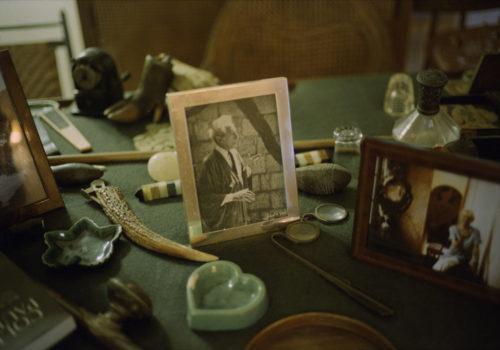Mauro Restiffe’s photographs at Villa Sauber capture the spirit of Santo Sospir, the villa Jean Cocteau lived in and decorated in Saint-Jean-Cap-Ferrat between 1950 and 1962.
When he entered Santo Sospir for the first time in the spring of 1950, Jean Cocteau was sixty years old. Build in Saint-Jean Cap-Ferrat, overlooking the harbor of Villefranche-sur-Mer, the villa was a haven of peace for him, reminiscent of his youthful days on the Côte d’Azur in the early 1920s, when he stayed at the nearby Hotel Welcome. Invited by his friend Francine Weisweiller to stay for a few days, he settled there for several years – twelve years to be precise – and left his mark on the white walls: he “tattooed” the immaculate cymas, creating a linear decor, similar to a horizon line, between drawing and writing, were developed throughout all the rooms. Drawing on an eminently mythological repertoire, the artist then elaborated a powerfully erotic iconographic program, placed under the sign of dreams and metamorphosis: figures of sailors, unicorns and poppy flowers gave the villa a new lease on life. In contrast to a total work of art, Cocteau conceived his intervention as a process of accumulation, bringing together the many heterogeneous elements to create a hybrid work.
In 2018, Mauro Restiffe (b. 1970, São José do Rio Pardo, Brazil) was invited to the Villa Santo Sospir before it was closed for restoration. Staying alone in the house preserved intact since Cocteau’s death, Restiffe produced a series of photographs in line with his own research into architecture, memory and intimacy. Using exclusively analogue techniques, his images bear witness to a constant dialogue between man and his environment, a whole bundle of tenuous links at the very foundation of Genius Loci. Restiffe uses photography to auscultate the genius of places, extracting their singular phenomenology from the visible. Presented emptied of all human presence, as if in the throes of temporary abandonment, Santo Sospir can be apprehended through a whole series of irreducible traces, for it is truly Cocteau’s identity that resurrects the phantasmal image of the villa. Cocteau’s haunting presence, like his imprint, takes up the whole of the tangible space offered by the image, which nonetheless comes alive with a life of its own.
In creating his images, Restiffe models his staging on the scenography of the site, thus doubling the architecture of his own visual construction. The photographer uses the latter as a fulcrum for structuring the space of his photographs: a particular window or door frame determines his point of view and placement, redirecting attention to significant elements in the surrounding furnishings. Confronted with the power of the scenery, Restiffe doesn’t hesitate to emphasize the life of the tattooed objects and walls. Santo Sospir has retained all its old-fashioned character, and the image seems haunted, inhabited by a past that animates walls and furniture. Antique vases and beautifully crafted pedestal tables contribute to the scene’s refined, timeless decor: shot against the light in front of a bay window through which the sun’s rays shine, they reveal a real subtlety in the rendering of light. The proofs are crepuscular or ashen, and although not expressly represented, Cocteau’s shadow hovers, volatile and ethereal, in all its ghostly presence. With a cinematic sensibility, the eye is trained to move from frontal views to a precise focus on points of detail. Santo Sospir thus gives free rein to the infiltration of an absence where the ineffable and the poetics of silence, which together nourish an idea of “atmosphere”, are required to reach beyond representation. For the photographer never ceases to feel the absence of the artist who gave flesh to this domestic landscape, which bears the imprint of private events. By extension, it becomes a metaphor for the individual, the receptacle of his or her conscious and unconscious memory. By giving pride of place to the invisible and elusive, Restiffe abandons the material principle of the gaze for the more mysterious realms of vision. These enigmatic images seem more dream than reality. The dual nature of Villa Santo Sospir, both tangible and memorial, is thus revisited.
Orchestrated by Célia Bernasconi, curator at Monaco’s Nouveau Musée National and a specialist in Cocteau’s work, the exhibition at Villa Sauber takes the form of a veritable stroll, rich in metaphor and meaning. Inspired by the eminently transgressive dimension of this protean work, it offers a silent dialogue between the images of Restiffe and a selection of drawings, paintings, tapestries and films by the poet, whose work is governed by a reminiscence of ancient myths, foremost among which are Hypnos and Thanatos, the figures of sleep and death. These twin brothers are none other than the sons of Nyx, literally night, which forms the artist’s privileged space. Sleep, dream and pleasure thus form a trinity that seems to govern all Restiffe’s images, tinting them with a perfume of dreaminess and strangeness. What’s more, the space is at times ordered like a veritable psychogram, revealing the dreams of its past inhabitants.
Among the works on display are numerous representations of opium smokers who, caught in an artificial sleep, find themselves immersed in truly narcotic depths, all necessary for a suspension experienced as a veritable extraction from space and time. In a similar way, the prints in Restiffe blur temporal markers, revealing the traces of a ghostly presence, revisiting one of the poet’s favorite themes, who passed away in 1963.
Maud de la Forterie
Santo Sospir – Mauro Restiffe
Curator : Célia Bernasconi
13 juin au 15 octobre 2023
Villa Sauber
17 Av. Princesse Grace
98000 Monaco
www.nmnm.mc
















